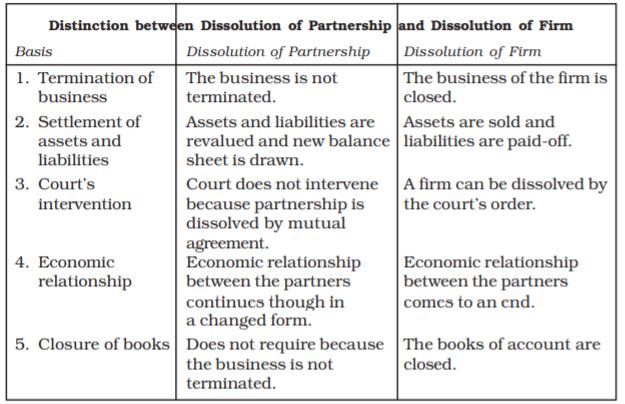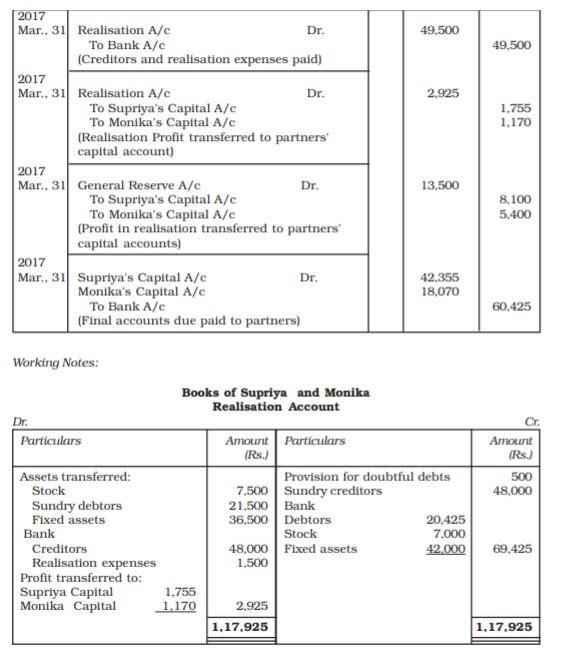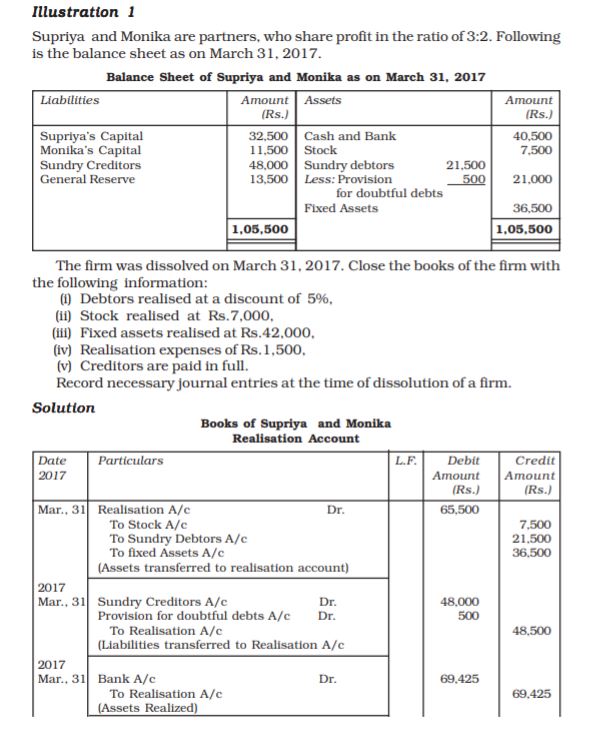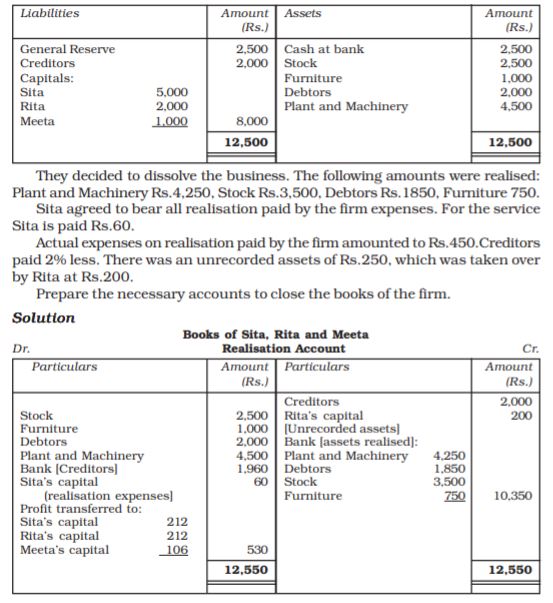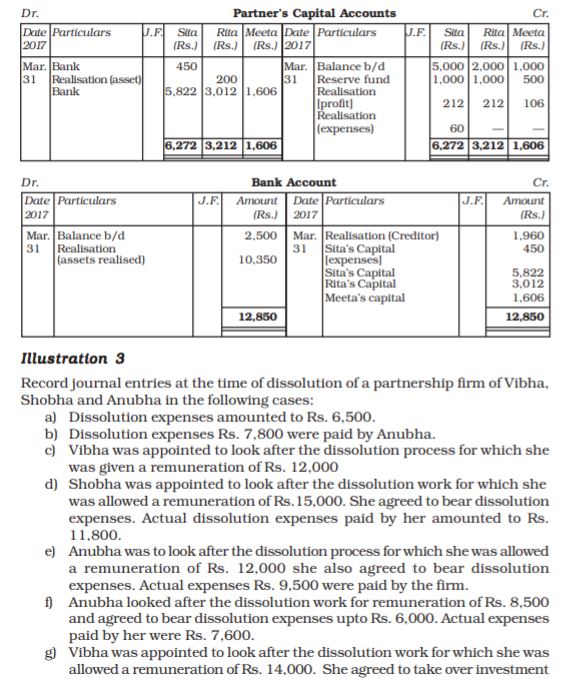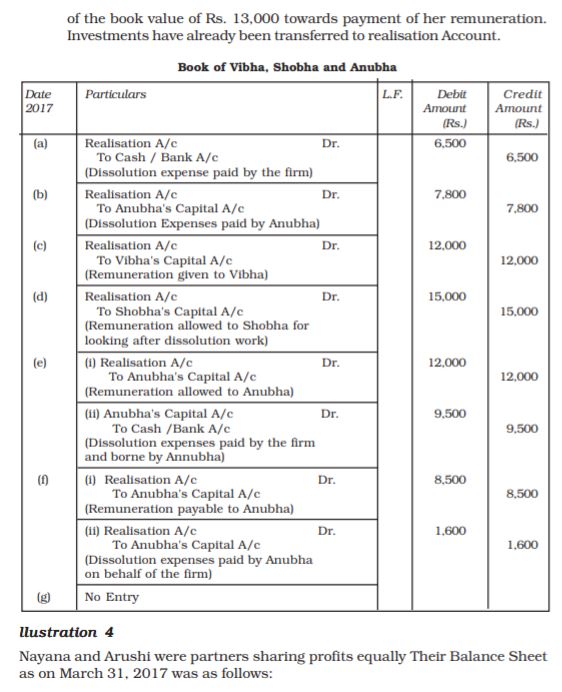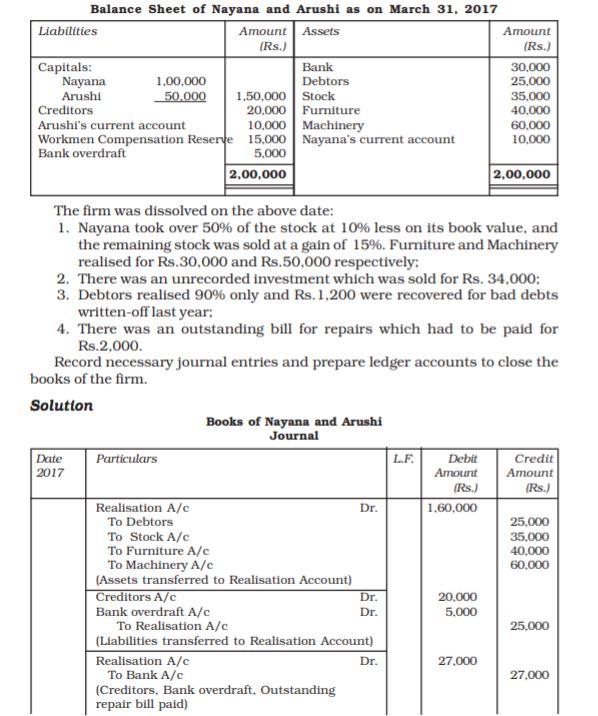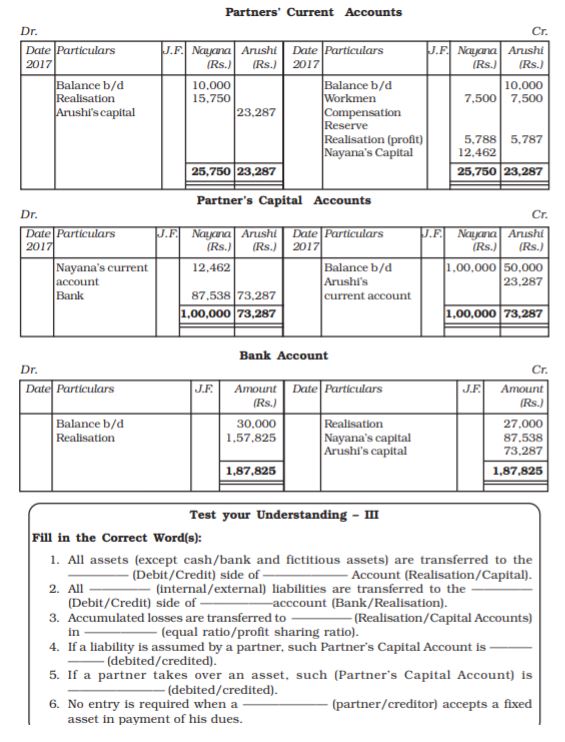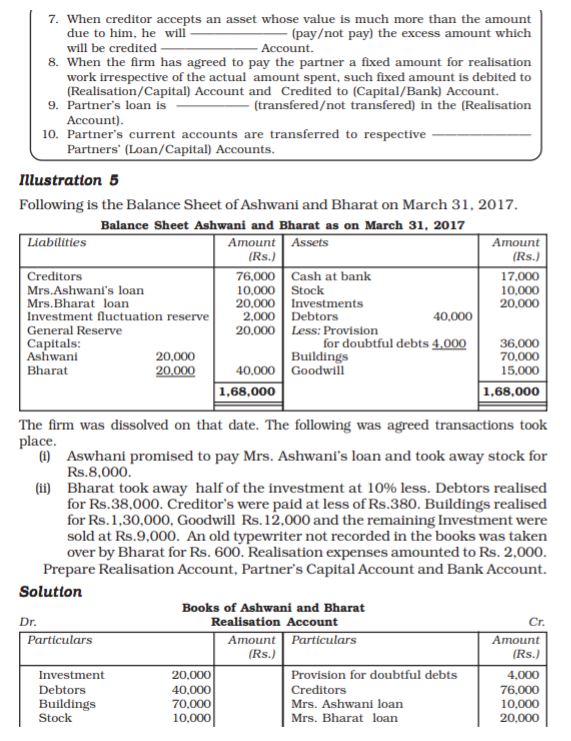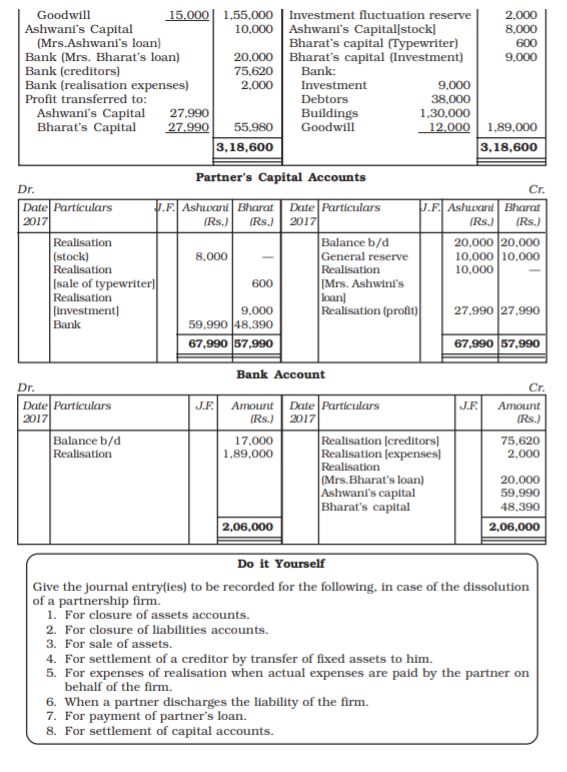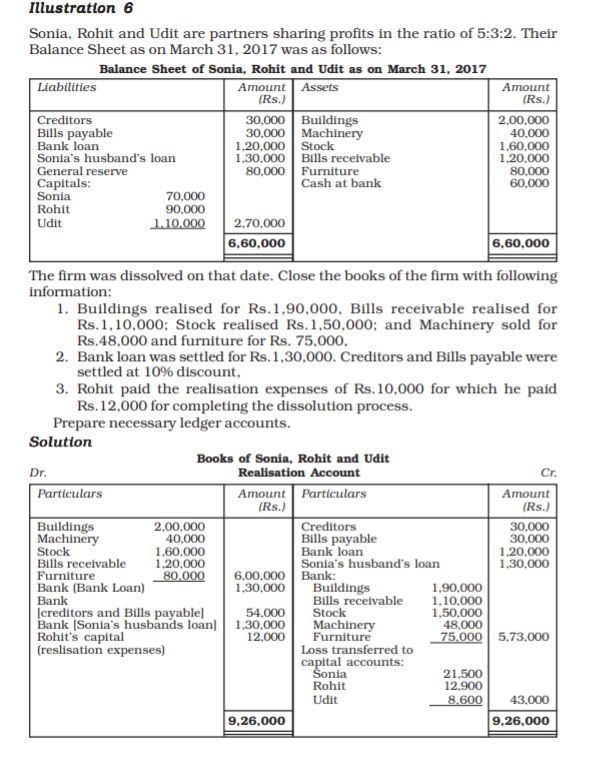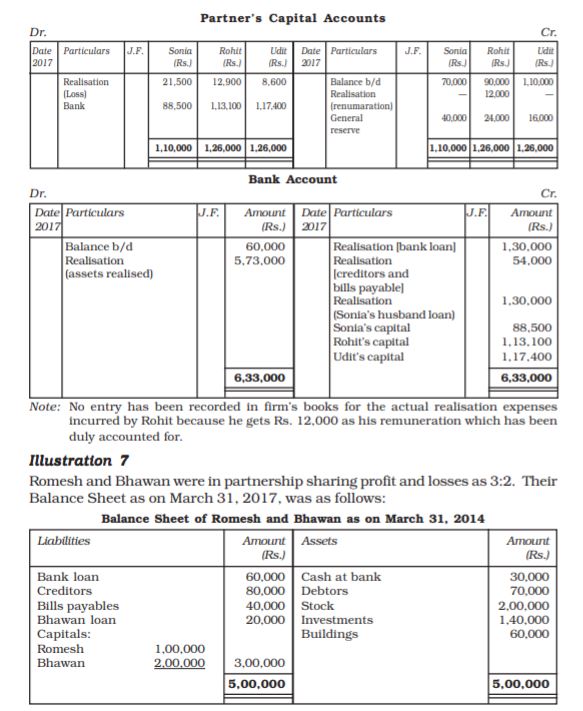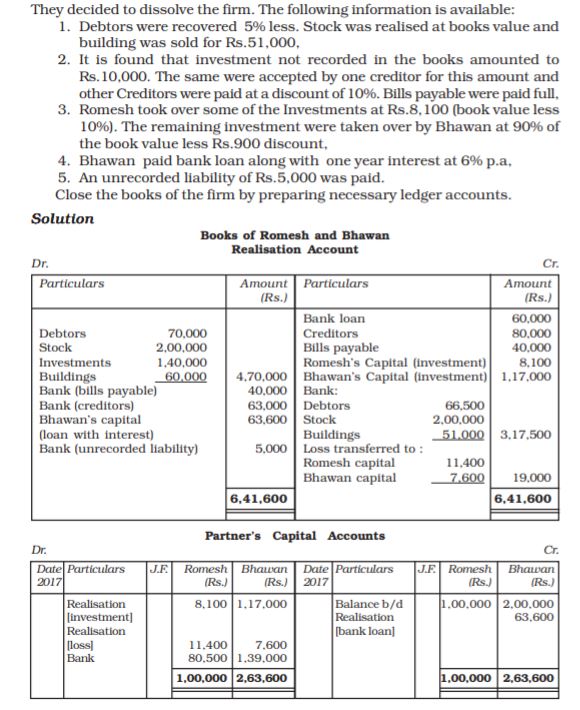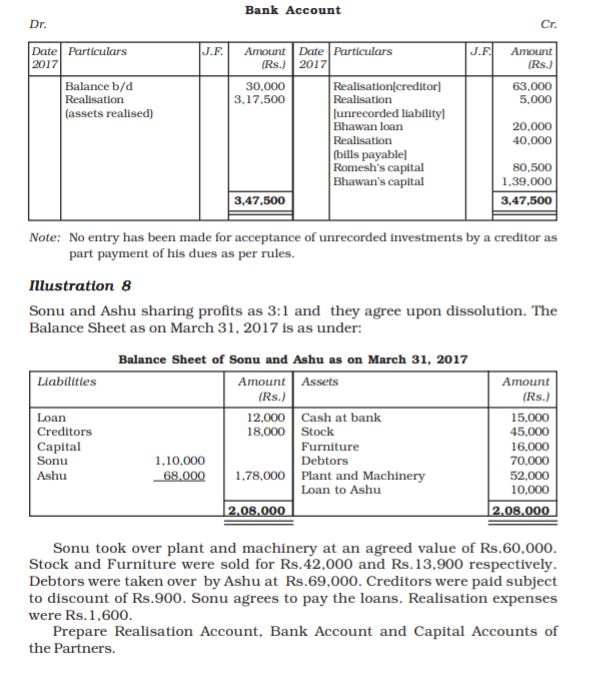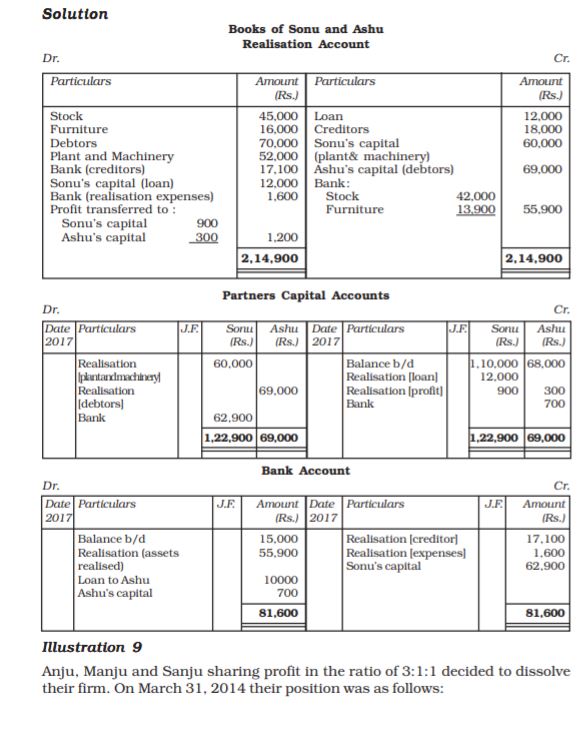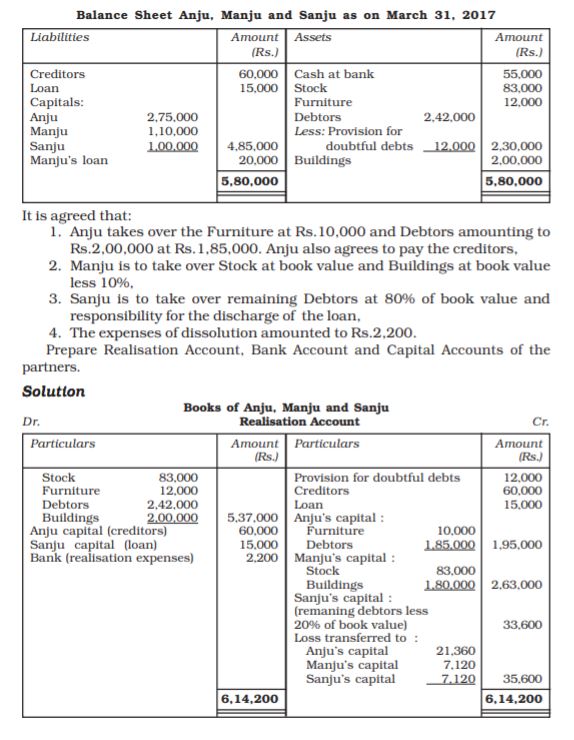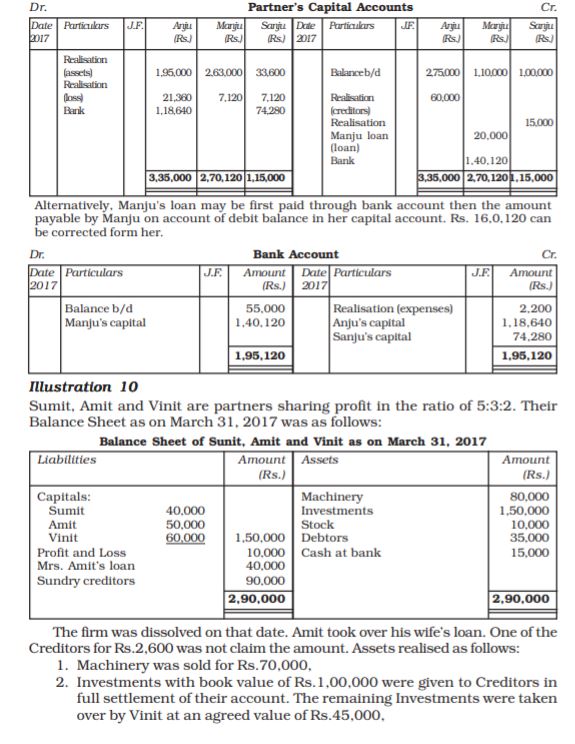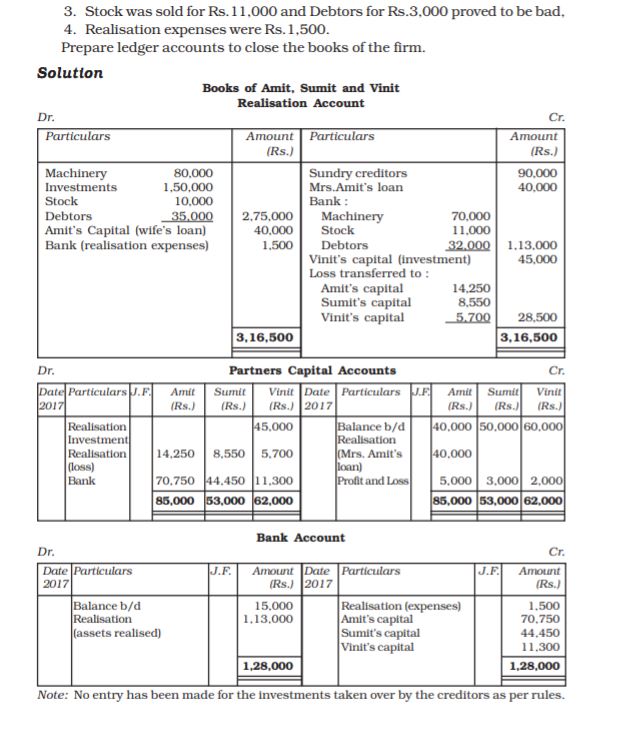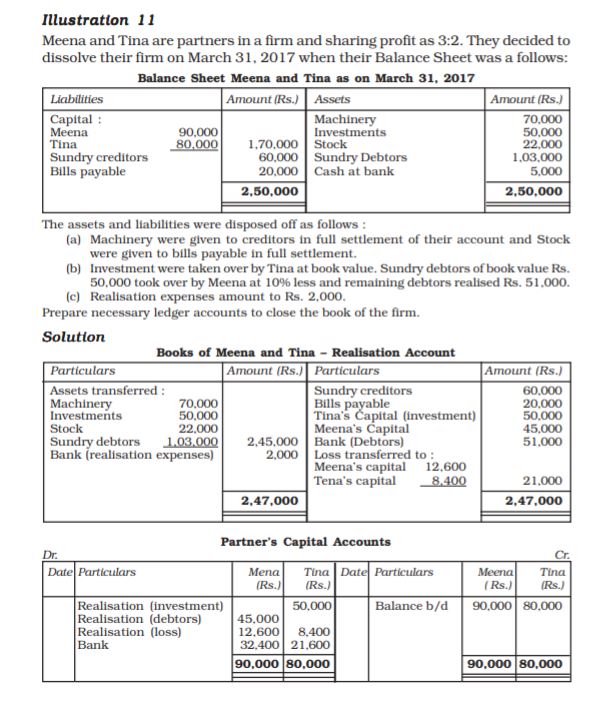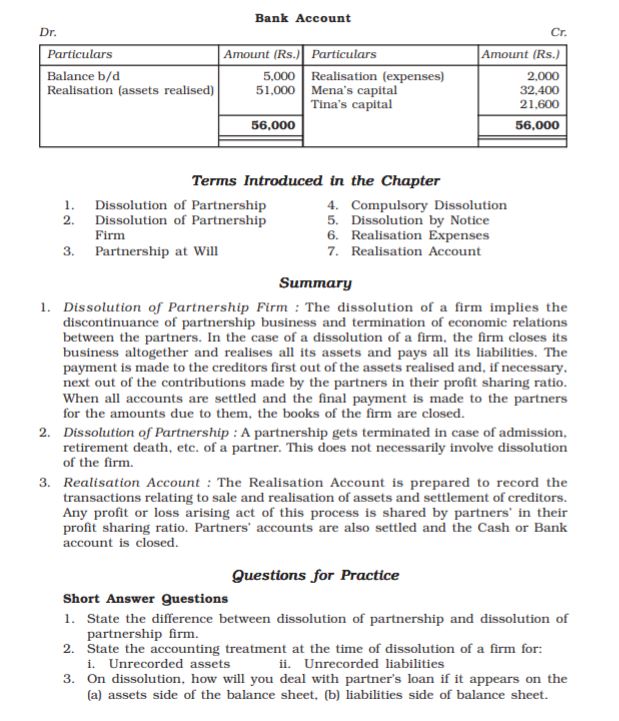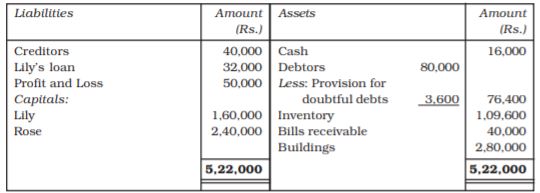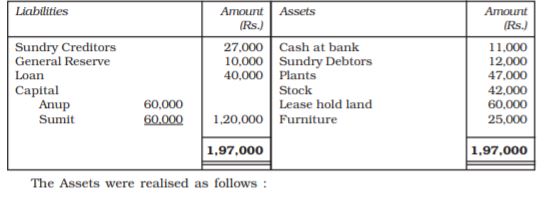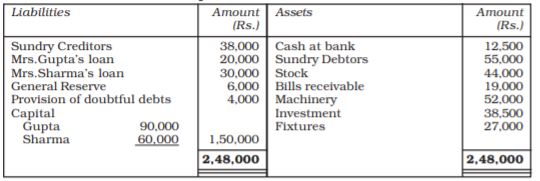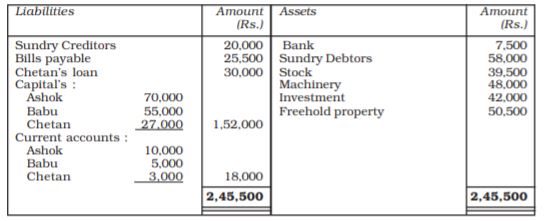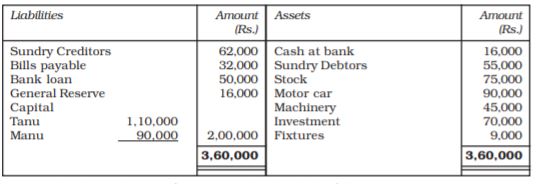Table of Contents

5
Dissolution of Partnership Firm
Learning Objectives
After studying this chapter you will be able to :
• State the meaning of dissolution of partnership firm;
• Differentiate between dissolution of partner-ship and dissolution of a partnership firm;
• Describe the various modes of dissolution of the partnership firm;
• Explain the rules relating to the settlement of claims among all partners;
• Prepare Realisation Account;
You have learnt about the reconstitution of a partnership firm which takes place on account of admission, retirement or death of a partner. In such a situation while the existing partnership is dissolved, the firm may continue under the same name if the partners so decide. In other words, it results in the dissolution of a partnership but not that of the firm. According to Section 39 of the partnership Act 1932, the dissolution of partnership between all the partners of a firm is called the dissolution of the firm. That means the Act recognises the difference in the breaking of relationship between all the partners of a firm and between some of the partners; and it is the breaking or discontinuance of relationship between all the partners which is termed as the dissolution of partnership firm. This brings an end to the existence of firm, and no business is transacted after dissolution except the activities related to closing of the firm as the affairs of the firm are to be wound up by selling firm’s assets and paying its liabilities and discharging the claims of the partners.
5.1 Dissolution of Partnership
As stated earlier dissolution of partnership changes the existing relationship between partners but the firm may continue its business as before. The dissolution of partnership may take place in any of the following ways:
(1) Change in existing profit sharing ratio among partners;
(2) Admission of a new partner;
(3) Retirement of a partner;
(4) Death of a partner;
(5) Insolvency of a partner;
(6) Completion of the venture, if partnership is formed for that; and
(7) Expiry of the period of partnership, if partnership is for a specific period of time;
5.2 Dissolution of a Firm
Dissolution of a partnership firm may take place without the intervention of court or by the order of a court, in any of the ways specified later in this section.
It may be noted that dissolution of the firm necessarily brings in dissolution of the partnership. However, dissolution of partnership would not necessarily involve dissolution of firms.
Dissolution of a firm takes place in any of the following ways:
1. Dissolution by Agreement: A firm is dissolved :
(a) with the consent of all the partners or
(b) in accordance with a contract between the partners.
2. Compulsory Dissolution: A firm is dissolved compulsorily in the following cases:
(a) when all the partners or all but one partner, become insolvent, rendering them incompetent to sign a contract;
(b) when the business of the firm becomes illegal; or
(c) when some event has taken place which makes it unlawful for the partners to carry on the business of the firm in partnership, e.g., when a partner who is a citizen of a country becomes an alien enemy because of the declaration of war with his country and India.
3. On the happening of certain contingencies: Subject to contract between the partners, a firm is dissolved :
(a) if constituted for a fixed term, by the expiry of that term;
(b) if constituted to carry out one or more ventures, by the completion thereof;
(c) by the death of a partner;
(d) by the adjudication of a partner as an insolvent.
4. Dissolution by Notice: In case of partnership at will, the firm may be dissolved if any one of the partners gives a notice in writing to the other partners, signifying his intention of seeking dissolution of the firm.
5. Dissolution by Court: At the suit of a partner, the court may order a partnership firm to be dissolved on any of the following grounds:
(a) when a partner becomes insane;
(b) when a partner becomes permanently incapable of performing his duties as a partner;
(c) when a partner is guilty of misconduct which is likely to adversely affect the business of the firm;
(d) when a partner persistently commits breach of partnership agreement;
(e) when a partner has transferred the whole of his interest in the firm to a third party;
(f) when the business of the firm cannot be carried on except at a loss; or
(g) when, on any ground, the court regards dissolution to be just and equitable.
Test your Understanding – I
State giving reasons, which of the following statements are true or false:
1. Dissolution of a partnership is different from dissolution of a firm,
2. A partnership is dissolved when there is a death of a partner,
3. A firm is dissolved when all partners give consent to it.
4. A firm is compulsorily dissolved when a partner decide to retire.
5. Dissolution of a firm necessarily involves dissolution of partnership.
6. A firm is compulsorily dissolved when all partners or when all except one partner become involvent.
7. Court can order a firm to be dissolved when a partner becomes insane.
8. Dissolution of partnership can not take place without intervention of the court.
5.3 Settlement of Accounts
In case of dissolution of a firm, the firm ceases to conduct business and has to settle its accounts. For this purpose, it disposes off all its assets for satisfying all the claims against it. In this context it should be noted that, subject to agreement among the partners, the following rules as provided in Section 48 of the Partnership Act 1932 shall apply.
(a) Treatment of Losses
Losses, including deficiencies of capital, shall be paid :
(i) first out of profits,
(ii) next out of capital of partners, and
(iii) lastly, if necessary, by the partners individually in their profit sharing ratio.
(b) Application of Assets
The assets of the firm, including any sum contributed by the partners to make up deficiencies of capital, shall be applied in the following manner and order:
(i) In paying the debts of the firm to the third parties;
(ii) In paying each partner proportionately what is due to him/her from the firm for advances as distinguished from capital (i.e. partner’ loan);
(iii) In paying to each partner proportionately what is due to him on account of capital; and
(iv) the residue, if any, shall be divided among the partners in their profit sharing ratio.
Thus, the amount realised from assets along with contribution from partners, if required, shall be utilised first to pay off the outside liabilities of the firm such as creditors, loans, bank overdraft, bill payables, etc. (it may be noted that secured loans have precedence over the unsecured loans); the balance should be applied to repay loans made by the partners to the firm. (in case the balance amount is not adequate enough to pay off such loans and advances, they are to be paid propartionately). The amount left thereafter is utilised in settlement of capital account balances. Then the surplus if any is divided among partners in their profit sharing ratio.
Private Debts and Firm’s Debts: Where both the debts of the firm and private debts of a partner co-exist, the following rules, as stated in Section 49 of the Act, shall apply.
(a) The property of the firm shall be applied first in the payment of debts of the firm and then the surplus, if any, shall be divided among the partners as per their claims, which can be utilised for payment of their private liabilities.
(b) The private property of any partner shall be applied first in payment of his private debts and the surplus, if any, may be utilised for payment of the firm’s debts, in case the firm’s liabilities exceed the firm’s assets.
It may be noted that the private property of the partner does not include the personal properties of his wife and children. Thus, if the assets of the firm are not adequate enough to pay off firm’s liabilities, the partners have to contribute out of their net private assets (private assets minus private liabilities).
Inability of a Partner to Contribute Towards Deficiency
In the context of settlement of accounts among the partners there is still another important aspect to be noted, i.e., when a partner is unable to contribute towards the deficiency of his capital account (the account finally showing a debit balance), he/she is said to be insolvent, and the sum not recoverable is treated as capital loss for the firm. In the absence of any agreement, to the contrary, such a capital loss is to be borne by the remaining solvent partners in accordance with the principle laid down in Garner vs. Murray case, which states that the solvent partners have to bear such loss in the ratio of their capitals as on the date of dissolution. However, the accounting treatment relating to dissolution of partnership on account of insolvency of partners is not being taken up at this stage.
5.4 Accounting Treatment
When the firm is dissolved, its books of account are to be closed and the profit or loss arising on realisation of its assets and discharge of liabilities is to be computed. For this purpose, a Realisation Account is prepared to ascertain the net effect (profit or loss) of realisation of assets and payment of liabilities which may be is transferred to partner’s capital accounts in their profit sharing ratio. Hence, all assets (other than cash in hand bank balance and fictitious assets, if any), and all external liabilities are transferred to this account. It also records the sale of assets, and payment of liabilities and realisation expenses. The balance in this account is termed as profit or loss on realisation which is transferred to partners’ capital accounts in the profit sharing ratio (see figure 5.1).
Realisation Account
5.4.1 Journal Entries
1. For trnasfer of assets
All asset accounts excluding cash, bank and the fictitious assets, if any are closed by transfer to the debit of Realisation Account at their book values. It may be noted that sundry debtors are transferred at gross value and the provision for doubtful debts is transferred to the credit side of Realisation Account along with liabilities. The same thing will apply to fixed assets, if provision for depreciation account is maintained.
Realisation A/c Dr.
To Assets (Individually) A/c
2. For transfer of liabilities
All external liability accounts including provisions, if any, are closed by transferring them to the credit of Realisation account.
Liabilities (individually) Dr.
To Realisation A/c
3. For sale of assets
Bank A/c Dr.
To Realisation A/c
4. For an asset taken over by a partner
Partner’s Capital A/c Dr.
To Realisation A/c
5. For payment of liabilities
Realisation A/c Dr.
To Bank A/c
6. For a liability which a partner takes responsibility to discharge
Ralisation A/c Dr.
To Partner’s Capital A/c
7. For settlement with the creditor through transfer of assets when a creditor accepts an asset in full and final settlement of his account, journal entry needs to be recorded. But, if the creditor accepts an asset only as part payment of his/her dues, the entry will be made for cash payment only. For example, a creditor to whom Rs. 10,000 was due accepts office equipment worth
Rs. 8,000 and is paid Rs. 2,000 in cash, the following entry shall be made for the payment of Rs. 2,000 only.
Realisation A/c Dr.
To Bank A/c
However, when a creditor accepts an asset whose value is more than the due amount he/she pay cash to the firm for the difference for which the entry will be:
Bank A/c Dr.
To Realisation A/c
8. For payment of realisation expenses
(a) When some expenses are incurred and paid by the firm in the process of realisation of assets and payment of liabilities:
Realisation A/c Dr.
To Bank A/c
(b) When realisation expenses are paid by a partner on behalf of the firm:
Realisation A/c Dr.
To Partner’s Capital A/c
(c) When a partner has agreed to bear the realisation expenses:
(i) if payment of realisation expenses is made by the firm
Partner’s Capital A/c Dr.
To Bank A/c
(ii) if the partner himself pays the realisation expenses, no entry is required
Note: In the absence of information about who is paying the expenses, it is implied that expenses are paid by the partner who has agreed to bear expenses.
9. For agreed remuneration to such partner who agrees to undertake the dissolution work.
Realisation A/c Dr.
To Partner’s Capital A/c
10. For realisation of any unrecorded assets including goodwill, if any
Bank A/c Dr.
To Realisation A/c
11. For settlement of any unrecorded liability
Realisation A/c Dr.
To Bank A/c
12. For transfer of profit and loss on realisation (Cr. Blance)
(a) In case of profit on realisation
Realisation A/c Dr.
To Partners’ Capital A/c (individually) A/c
(b) In case of loss on realisation
Partners’ Capital A/c (individually) Dr. (Dr. Blance)
To Realisation A/c
13. For settlement of loan by a firm to a partner:
Bank A/c Dr.
To loan to partners A/c
14. For transfer of accumulated profits in the form of general reserve to partners’ capital accounts in their profit sharing ratio:
General Reserve A/c Dr.
To Partners’ Capital A/c (individually)
15. For transfer of fictitious assets, if any, to partners’ capital accounts in their profit sharing ratio:
Partners’ Capital A/c (individually) Dr.
To Fictitious Asset A/c
16. For payment of loans due to partners
Partner’s Loan A/c Dr.
To Bank A/c
17. For settlement of partners’ accounts
If the partner’s capital account shows a debit balance after posting of rebount entries firms. He brings in the necessary cash for which the entry will be:
Bank A/c Dr.
To Partner’s Capital A/c
The balance is paid to partners whose capital accounts show a credit balance and the following entry is recorded.
Partners’ Capitals A/cs (individually) Dr.
To Bank A/c
It may be noted that the aggregate amount finally payable to the partners must equal to the amount available in bank and cash accounts. Thus, all accounts of a firm are closed in case of dissolution.
Test your Understanding – II
Tick () the Correct Answer
1. On dissolution of a firm, bank overdraft is transferred to : (a) Cash Account
(b) Bank Account
(c) Realisation Aaccount
(d) Partner’s capital Account. 2. On dissolution of a firm, partner’s loan account is transferred to: (a) Realisation Account
(b) Partner’s Capital Account
(c) Partner’s Current Account
(d) None of the above.
3. After transferring liabilities like creditors and bills payables in the Realisation Account, in the absence of any information regarding their payment, such liabilities are treated as:
(a) Never paid
(b) Fully paid
(c) Partly paid
(d) None of the above.
4. When realisation expenses are paid by the firm on behalf of a partner, such expenses are debited to:
(a) Realisation Account
(b) Partner’s Capital Account
(c) Partner’s Loan Account
(d) None of the above.
5. Unrecorded assets when taken over by a partner are shown in :
(a) Debit of Realisation Account
(b) Debit of Bank Account
(c) Credit of Realisation Account
(d) Credit of Bank Account. 6. Unrecorded liabilities when paid are shown in: (a) Debit of Realisation Account
(b) Debit of Bank Account
(c) Credit of Realisation Account
(d) Credit of Bank Account. 7. The accumulated profits and reserves are transferred to : (a) Realisation Account
(b) Partners’ Capital Accounts
(c) Bank Account
(d) None of the above.
8. On dissolution of the firm, partner’s capital accounts are closed through: (a) Realisation Account
(b) Drawings Account (c) Bank Account (d) Loan Account.
Illustration 2
Sita, Rita and Meeta are partners sharing profit and losses in the ratio of 2:2:1 Their balance sheet as on March 31, 2017 is as follows:
Balance Sheet of Sita, Rita and Meeta as on March 31, 2017
4. Distinguish between firm’s debts and partner’s private debts.
5. State the order of settlement of accounts on dissolution.
6. On what account realisation account differs from revaluation account.
Long Answer Questions
1. Explain the process dissolution of partnership firm?
2. What is a Realisation Account?
3. Reproduce the format of Realisation Account.
4. How deficiency of crditors is paid off at the time of dissolution of firm.
Numerical Questions
1. Journalise the following transactions regarding realisation expenses :
[a] Realisation expenses amounted to Rs.2,500.
[b] Realisation expenses amounting to Rs.3,000 were paid by Ashok, one of the partners.
[c] Realisation expenses Rs.2,300 borne by Tarun, personally.
[d] Amit, a partner was appointed to realise the assets, at a cost of Rs.4,000. The actual amount of realisation expenses amounted to Rs.3,000.
2. Record necessary journal entries in the following cases:
[a] Creditors worth Rs.85,000 accepted Rs.40,000 as cash and Investment worth Rs.43,000, in full settlement of their claim.
[b] Creditors were Rs.16,000. They accepted Machinery valued at Rs.18,000 in settlement of their claim.
[c] Creditors were Rs.90,000. They accepted Buildings valued Rs.1,20,000 and paid cash to the firm Rs.30,000.
3. There was an old computer which was written-off in the books of accounts in the pervious year. The same has been taken over by a partner Nitin for Rs.3,000. Journalise the transaction when the firm has been dissolved.
4. What journal entries will be recorded for the following transactions on the dissolution of a firm:
[a] Payment of unrecorded liabilities of Rs.3,200.
[b] Stock worth Rs.7,500 is taken over by a partner Rohit.
[c] Profit on Realisation amounting to Rs.18,000 is to be distributed between the partners Ashish and Tarun in the ratio of 5:7.
[d] An unrecorded asset realised Rs.5,500.
5. Give journal entries for the following transactions :
1. To record the realisation of various assets and liabilities,
2. A Firm has a Stock of Rs. 1,60,000. Aziz, a partner took over 50% of the Stock at a discount of 20%,
3. Remaining Stock was sold at a profit of 30% on cost,
4. Land and Buildging (book value Rs. 1,60,000) sold for Rs. 3,00,000 through a broker who charged 2%, commission on the deal,
5. Plant and Machinery (book value Rs. 60,000) was handed over to a Creditor at an agreed valuation of 10% less than the book value,
6. Investment whose face value was Rs. 4,000 was realised at 50%.
6. How will you deal with the realisation expenses of the firm of Rashim and Bindiya in the following cases:
1. Realisation expenses amount to Rs. 1,00,000,
2. Realisation expenses amounting to Rs. 30,000 are paid by Rashim, a partner.
3. Realisation expenses are to be borne by Rashim and he will be paid Rs. 70,000 as remuneration for completing the dissolution process. The actual expenses incurred by Rashim were Rs. 1,20,000.
7. The book value of assets (other than cash and bank) transferred to Realisation Account is Rs. 1,00,000. 50% of the assets are taken over by a partner Atul, at a discount of 20%; 40% of the remaining assets are sold at a profit of 30% on cost; 5% of the balance being obsolete, realised nothing and remaining assets are handed over to a Creditor, in full settlement of his claim.
You are required to record the journal entries for realisation of assets.
8. Record necessary journal entries to realise the following unrecorded assets and liabilities in the books of Paras and Priya:
1. There was an old furniture in the firm which had been written-off completely in the books. This was sold for Rs. 3,000,
2. Ashish, an old customer whose account for Rs. 1,000 was written-off as bad in the previous year, paid 60%, of the amount,
3. Paras agreed to takeover the firm’s goodwill (not recorded in the books of the firm), at a valuation of Rs. 30,000,
4. There was an old typewriter which had been written-off completely from the books. It was estimated to realise Rs. 400. It was taken away by Priya at an estimated price less 25%,
5. There were 100 shares of Rs. 10 each in Star Limited acquired at a cost of Rs. 2,000 which had been written-off completely from the books. These shares are valued @ Rs. 6 each and divided among the partners in their profit sharing ratio.
9. All partners wish to dissolve the firm. Yastin, a partner wants that her loan of Rs. 2,00,000 must be paid off before the payment of capitals to the partners. But, Amart, another partner wants that the capitals must be paid before the payment of Yastin’s loan. You are required to settle the conflict giving reasons.
10. What journal entries would be recorded for the following transactions on the dissolution of a firm of Arti and Karim after various assets (other than cash) on the third party liabilities have been transferred to Reliasation account.
1. Arti took over the Stock worth Rs. 80,000 at Rs. 68,000.
2. There was unrecorded Bike of Rs. 40,000 which was taken over by Mr. Karim.
3. The firm paid Rs. 40,000 as compensation to employees.
4. Sundry creditors amounting to Rs. 36,000 were settled at a discount of 15%.
5. Loss on realisation Rs. 42,000 was to be distributed between Arti and Karim in the ratio of 3:4.
11. Rose and Lily shared profits in the ratio of 2:3. Their Balance Sheet on March 31, 2017 was as follows:
Balance Sheet of Rose and Lily as on March 31, 2017
Rose and Lily decided to dissolve the firm on the above date. Assets (except bills receivables) realised Rs. 4,84,000. Creditors agreed to take
Rs. 38,000. Cost of realisation was Rs. 2,400. There was a Motor Cycle in the firm which was bought out of the firm’s money, was not shown in the books of the firm. It was now sold for Rs. 10,000. There was a contingent liability in respect of outstanding electric bill of Rs. 5,000 which was paid Bill Receivable taken over by Rose at Rs. 33,000.
Show Realisation Account, Partners Capital Acount, Loan Account and Cash Account.
(Ans : Realisation Profit Rs. 15,600, Total of Cash Account Rs. 5,10,000, Lily’s capital Rs. 1,99,360, Rose capital Rs. 2,33,240).
12. Shilpa, Meena and Nanda decided to dissolve their partnership on March 31,2017. Their profit sharing ratio was 3:2:1 and their Balance Sheet was as under:
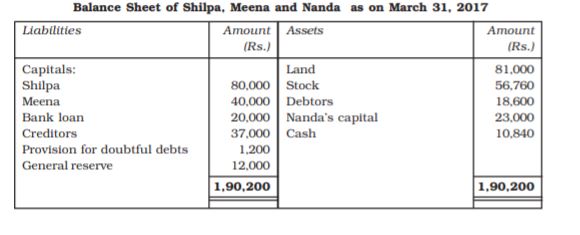
The stock of value of Rs. 41,660 are taken over by Shilpa for Rs. 35,000 and she agreed to discharge bank loan. The remaining stock was sold at Rs. 14,000 and debtors amounting to Rs. 10,000 realised Rs. 8,000. land is sold for Rs. 1,10,000. The remaining debtors realised 50% at their book value. Cost of realisation amounted to Rs. 1,200. There was a typewriter not recorded in the books worth Rs. 6,000 which were taken over by one of the Creditors at this value. Prepare Realisation Account.
(Ans : Profit on Realisation Rs. 20,940).
13. Surjit and Rahi were sharing profits (losses) in the ratio of 3:2, their Balance Sheet as on March 31, 2017 is as follows:
Balance Sheet of Surjit and Rahi as on March 31, 2017
The firm was dissolved on March 31, 2017 on the following terms:
1. Surjit agreed to take the investments at Rs. 8,000 and to pay Mrs. Surojit’s loan.
2. Other assets were realised as follows:
Stock Rs. 5,000
Debtors Rs. 18,500
Furniture Rs. 4,500
Plant Rs. 25,000
3. Expenses on realisation amounted to Rs. 1,600.
4. Creditors agreed to accept Rs. 37,000 as a final settlement.
You are required to prepare Realisation account, Partner’s Capital account and Bank account.
(Ans : Loss on Realisation Rs. 6,600, Total of Bank Account Rs. 64,500, Amount paid to Surjit Rs. 12,540, Rahi Rs. 8,360).
14. Rita, Geeta and Ashish were partners in a firm sharing profits/losses in the ratio of 3:2:1. On March 31, 2017 their balance sheet was as follows:
On the date of above mentioned date the firm was dissolved:
1. Rita was appointed to realise the assets. Rita was to receive 5% commission on the sale of assets (except cash) and was to bear all expenses of realisation,
2. Assets were realised as follows:
Rs.
Debtors 30,000
Stock 26,000
Plant 42,750
3. Investments were realised at 85% of the book value,
4. Expenses of realisation amounted to Rs. 4,100,
5. Firm had to pay Rs. 7,200 for outstanding salary not provided for earlier,
6. Contingent liability in respect of bills discounted with the bank was also materialised and paid off Rs. 9,800,
Prepare Realisation account, Capital Accounts of Partner’s and Cash Account.
(Ans : Loss on Realisation Rs. 1,15,970, Total of Cash Account Rs. 1,79,900; Amount paid to Rita Rs. 39,885, Geeta Rs. 18,010).
15. Anup and Sumit are equal partners in a firm. They decided to dissolve the parntership on March 31, 2017. When the balance sheet is as under :
Balance Sheet of Anup and Sumit as on March 31, 2017
Furniture 22,500
Stock 40,500
Plant 48,000
Sundry Debtors 10,500
The Creditors were paid Rs. 25,500 in full settlement. Expenses of realisation amount to Rs. 2,500.
Prepare Realisation Account, Bank Account, Partners Capital Accounts to close the books of the firm.
(Ans : Realisation Profit Rs. 6,500; Total of Bank Account Rs. 2,04,500, Amount paid to Anup Rs. 68,250, Sumit Rs. 68,250).
16. Ashu and Harish are partners sharing profit and losses as 3:2. They decided to dissolve the firm on March 31, 2017. Their balance sheet on the above date was:
Balance Sheet of Ashu and Harish as on March 31, 2017
Ashu is to take over the building at Rs. 95,000 and Machinery and Furniture is take over by Harish at value of Rs. 80,000. Ashu agreed to pay Creditor and Harish agreed to meet Bank overdraft. Stock and Investments are taken by both partner in profit sharing ratio. Debtors realised for Rs. 46,000, expenses of realisation amounted to Rs. 3,000. Prepare necessary ledger account.
(Ans : Profit on Realisation Rs. 6,000, Cash/Bank Total Rs. 59,600; Paid to Ashu Rs. 56,600, paid to Harish Rs. 5,600)
17. Sanjay, Tarun and Vineet shared profit in the ratio of 3:2:1. On march 31,2017 their balance sheet was as follows :
Balance Sheet of Sanjay, Tarun and Vineet as on March 31, 2017
On this date the firm was dissolved. Sanjay was appointed to realise the assets. Sanjay was to receive 6% commission on the sale of assets (except cash) and was to bear all expenses of realisation.
Sanjay realised the assets as follows : Plant Rs. 72,000, Debtors Rs. 54,000, Furniture Rs. 18,000, Stock 90% of the book value, Investments Rs. 76,000 and Bills receivable Rs.31,000. Expenses of realisation amounted to Rs.4,500.
Prepare Realisation Account, Capital Accounts and Cash Account
(Ans : Loss on Realisation Rs.61,300, Total of Cash Account Rs.3,37,000; Amount paid to Sanjay Rs. 87,650, Tannu Rs. 79,567, Vineet Rs. 59,783).
18. The following is the Balance Sheet of Gupta and Sharma as on March 31,2017:
Balance Sheet of Gupta and Sharma as on March 31, 2017
The firm was dissolved on December 31, 2017 and asset realised and settlements of liabilities as follows:
(a) The realisation of the assets were as follows:
Rs.
Sundry Debtors 52,000
Stock 42,000
Bills receivable 16,000
Machinery 49,000
Fixtures 20,000
(b) Investment was taken over by Gupta at agreed value of Rs.36,000 and agreed to pay of Mrs. Gupta’s loan.
(c) The Sundry Creditors were paid off less 3% discount.
(d) The realisation expenses incurred amounted to Rs.1,200.
Journalise the entries to be made on the dissolution and prepare Realisation Account, Bank Account and Partners Capital Accounts.
(Ans : Loss on Realisation Rs.36,560, Total of Bank Account; Rs. 1,91,500; Amount paid to Gupta Rs. 68,720, Sharma, Rs. 54,720)
19. Ashok, Babu and Chetan are in partnership sharing profit in the proportion of 1/2, 1/3, 1/6 respectively. They dissolve the partnership of the December 31, 2017, when the balance sheet of the firm as under:
Balance Sheet of Ashok, Babu and Chetan as on December 31, 2017
The machinery was taken over by Babu for Rs.45,000, Ashok took over the Investment for Rs.40,000 and Freehold property took over by Chetan at Rs.55,000. The remaining Assets realised as follows: Sundry Debtors Rs.56,500 and Stock Rs.36,500. Sundry Creditors were settled at discount of 7%. A Office computer, not shown in the books of accounts realised Rs.9,000. Realisation expenses amounted to Rs.3,000.
Prepare Realisation Account, Partners Capital Account, Bank Account.
(Ans : Profit on Realisation Rs.2,400, Total of Cash Account Rs.1,34,100; Amount paid to Ashok Rs. 41,800, Babu Rs. 15,800, Amount paid towards Chetan’s loan Rs. 5,400)
20. The following is the Balance sheet of Tanu and Manu, who shares profit and losses in the ratio of 5:3, On March 31,2017:
Balance Sheet of Tanu and Manu as on March 31, 2017
On the above date the firm is dissolved and the following agreement was made:
Tanu agree to pay the bank loan and took away the sundry debtors. Sundry creditors accepts stock and paid Rs.10,000 to the firm. Machinery is taken over by Manu for Rs.40,000 and agreed to pay of bills payable at a discount of 5%.. Motor car was taken over by Tanu for Rs.60,000. Investment realised Rs.76,000 and fixtures Rs.4,000. The expenses of dissolution amounted to Rs.2,200.
Prepare Realisation Account, Bank Account and Partners Capital Accounts.
(Ans : Loss on Ralisation Rs.37,600, Total of Bank Account Rs.1,06,000; Amount pait to Tannu Rs. 31,500, Manu Rs. 72,300)
Check-list to Check your Understanding
Test your Understanding – I
1. True, 2 True, 3. True, 4. False, 5. True, 6. True, 7. True, 8. False.
Test your Understanding – II
1. (c), 2. (d), 3. (b), 4. (b), 5. (c), 6. (a), 7. (b), 8. (c)
Test your Understanding – III
1. Debit, Realisaton, 2. External, Credit, Realisation, 3. Capital Accounts, Profit sharing ratio. 4. Credited, 5. Debited, 6. Creditor, 7. Pay, Realisation, 8. Realisation, Capital, 9. Not recorded, 10. Capital.
